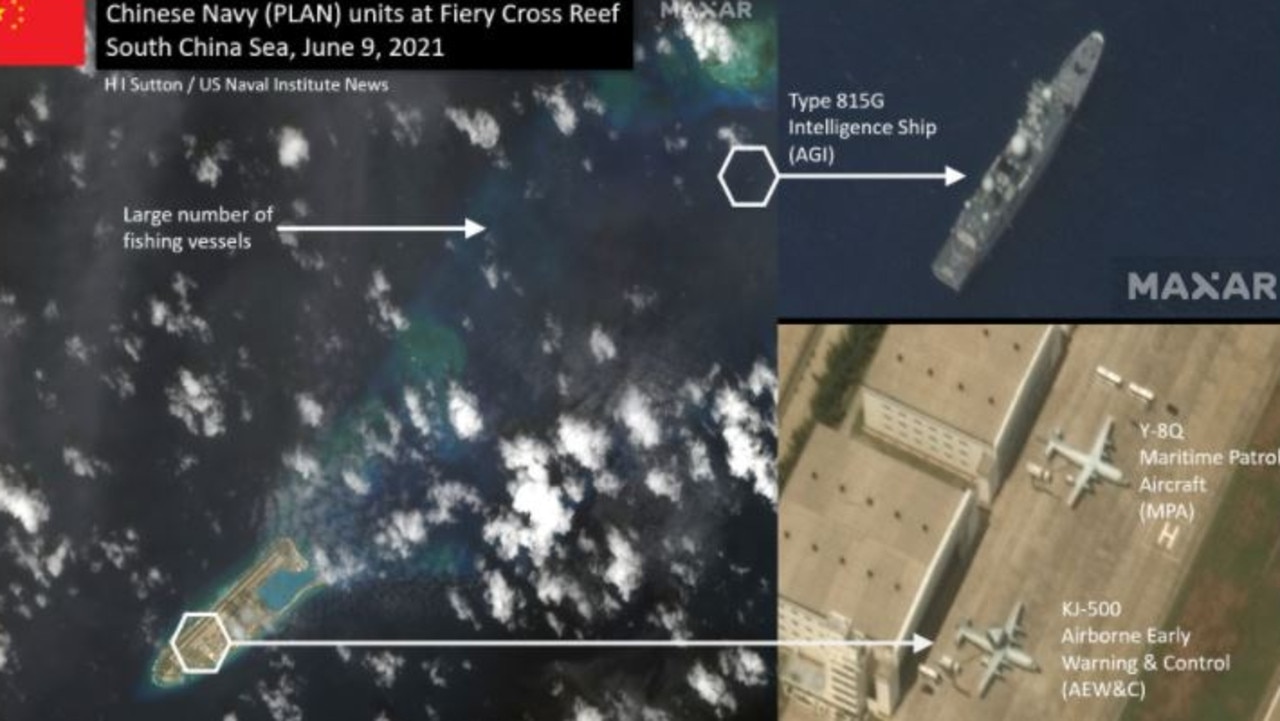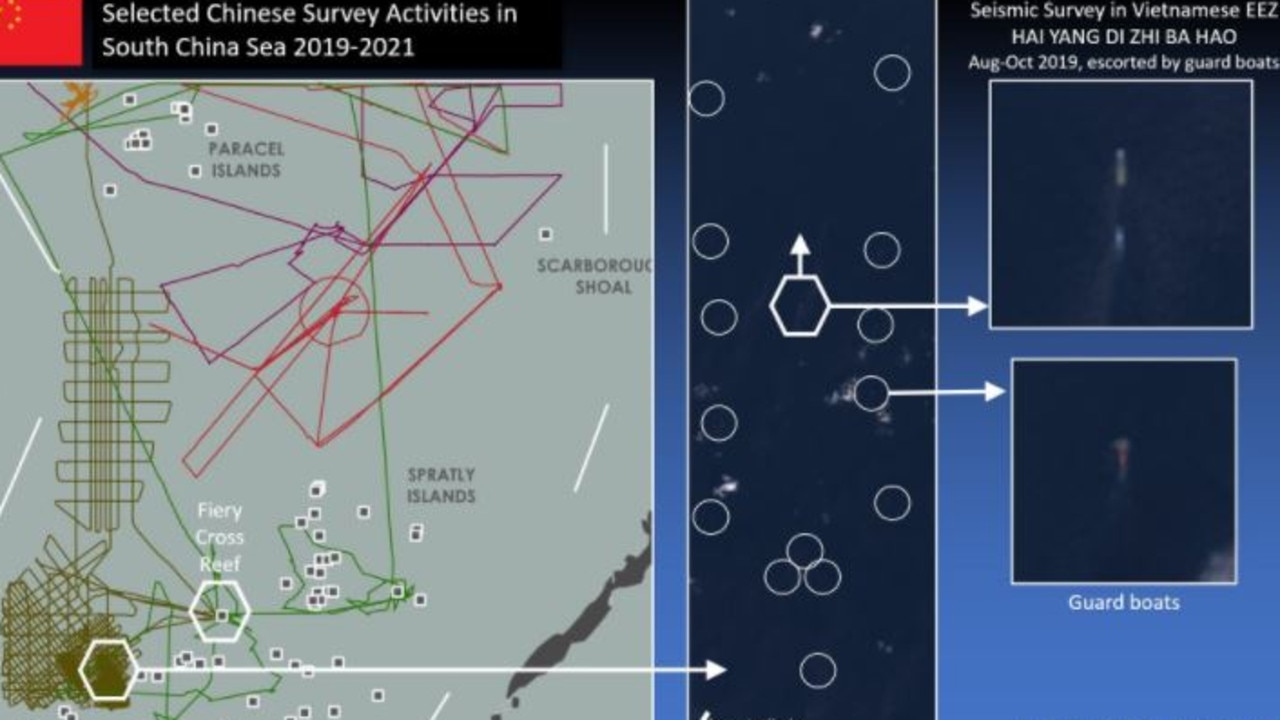Beijing’s South China Sea military presence grows amid US, Australian pushback
Satellite photos have revealed alarming – and “nefarious” – new details of what Beijing is really getting up to in the South China Sea.
Satellite photos reveal a military radar surveillance aircraft, anti-submarine aircraft and an armed navy intelligence ship are at Fiery Cross Reef in the Spratly Islands.
This is odd – if you believe Beijing’s assertions that these massive island fortresses are purely for civilian search and rescue purposes.
Since 2012, China has engaged in a dramatic building program in the Paracel and Spratly Islands and Scarborough Shoal.
The problem is, it doesn’t actually own these sites.
But that hasn’t stopped Beijing from constructing a vast network of fortresses – many with large airfields, hardened hangars and armoured towers holding weapons – in the name of “search and rescue”.
China has repeatedly insisted it has no intention to militarise the fortresses sitting among waters claimed by nations including Vietnam, the Philippines and Malaysia.
Nobody believed them.
New article #Chinese Navy (PLAN) surveillance ship (AGI) and aircraft on Fiery Cross Reef. We also looked at the massive survey activity in South China Sea and touch on Maritime Militia.
— H I Sutton (@CovertShores) June 10, 2021
Nod @Maxar, @MarineTraffic, @detresfa_ and unnamed others!https://t.co/o4keBpn4R2
And more evidence of Beijing’s “nefarious” intentions has recently come to light.
New satellite images from Google’s supplier Maxar show a gathering of military equipment on one of Beijing’s most significant artificial island outposts – Fiery Cross Reef in the Spratly Islands.
RELATED: China: Australia guilty of ‘abuse’

According to an analysis by the US Naval Institute, they reveal a naval warship – specifically a Type-815G surveillance ship – anchored in its lagoon. And sitting on its 3.3km long runway were a Y-8Q anti-submarine patrol aircraft and a KJ-500 airborne early warning and control (AWAC) aircraft.
And despite a recent blanket fishing ban issued by Beijing, many “fishing” vessels were also clustered nearby.
Fiery Cross
Beijing may be increasing its military presence in the Spratly Islands due to recent international “pushback”.
This year, the United States has increased its activities in the waters, with multiple visits by its aircraft carrier battle groups and “Freedom of Navigation Operations” by its warships.
European powers such as France, Germany and the United Kingdom have also made their presence felt in support of the United Nations law of the sea. As has Australia and Canada.
And directly affected nations such as the Philippines and Vietnam show signs of being emboldened by such support by openly defying their overbearing neighbour.
In the middle of it all sits Fiery Cross Reef.
Three planes spotted on Fiery Cross Reef in the South China Sea on June 5. I guess two grey planes are Y-8 MPAs. pic.twitter.com/rqO6jpI0Cv
— Duan Dang (@duandang) June 5, 2021
It’s one of seven heavily armed artificial island fortresses Beijing has scattered throughout the cluster of shoals, reefs and rocky outcrops that are the Spratlys in recent years.
Just on the horizon to its south is Thitu Island, known to the Philippines as Pag-asa Island. This 37ha natural island is the site of a small Filipina fishing settlement and a run-down runway.
It’s also the subject of an ongoing Chinese fishing militia “blockade”.
And then there’s the nearby Whitsun Reef. This was the scene of a Chinese sit in earlier this year, with more than 200 militia vessels tied up “sheltering from a storm” under perfect blue skies.
RELATED: China’s extreme measure to destroy covid

Amid it all, US surveillance aircraft activity has increased dramatically in recent months, says the Beijing-based South China Sea Strategic Probing Initiative. It reports 72 such flights over the South China Sea in May – up from 35 last year.
“The PLA’s military capabilities are constantly improving, and the US military is increasingly worried,” Chinese Communist Party military commentator Song Zhongping told local media. “On the other hand, the US military is also preparing for combat. Therefore, it has to increase reconnaissance against the PLA. This reminds us that we need to be prepared for military confrontations against the United States.”
#OSINT#PLAN#Navy#SouthChinaSea Fiery Cross Reef, 21-05-2021. A Type 054A Jiangkai II class frigate steaming out, perhaps expecting a visitor ? pic.twitter.com/VBfwl1zm31
— OSINT-1 (@OSINT_1) May 21, 2021
United States Pacific Air Forces General Kenneth Wilsbach responded by saying the increased number of flights was to monitor Beijing’s “nefarious activities”.
“We’d like to know a lot of … what I think is nefarious activities by the Chinese Communist Party,” he said.
“We wanna be able to track their military activities, we wanna be able to understand any testing, and acquisitions with new equipment that they made, that is why we are collecting.”
But it’s not just the West that is hardening its position against Beijing.
David versus Goliath
Despite the vacillations of its President, Rodrigo Duterte, Manila’s patience also appears to be running out.
It issued yet another formal diplomatic note to Beijing late last month. It protested “against the incessant deployment, prolonged presence, and illegal activities of Chinese maritime assets and fishing vessels in the vicinity of the Pag-asa Islands”.
“The Pag-asa Islands is an integral part of the Philippines over which it has sovereignty and jurisdiction,” the Foreign Ministry asserted.
RELATED: Key ally steps in over China stoush

Chairman of Manila’s strategic intelligence committee Johnny Pimentel says he wants to see the Philippines navy maintain a permanent presence in the Spratly Islands.
This is a direct pushback against Beijing’s ongoing pressure in the region.
“We want the Philippine navy positioned to prevent China from asserting administrative control over any reefs, rocks or lagoons within our 200-nautical mile exclusive economic zone. We should avoid a repeat of the 2012 incident where China was able to occupy Bajo de Masinloc (Scarborough Shoal),” Pimentel told local media.
According to the Asia Maritime Transparency Initiative (AMTI), 13 Philippines coast guard and military vessels visited the Spratly Islands and Scarborough Shoal 57 times in the space of the past three months.
“We expect the Navy’s two lead warships (guided-missile frigates BRP Jose Rizal and BRP Antonio Luna) to be posted in the FOBs and to routinely operate in the West Philippine Sea,” Pimentel added.
The Philippines parliament is debating a significant increase in the nation’s small defence budget. It has already resolved to buy four new frigates and 12 corvettes before 2028. It will also procure 18 patrol vessels and 40 fast-attack craft.
The current proposal is to build 12 new naval outposts throughout the Philippine archipelago. At least two of these are proposed for Palawan Island – the large Philippines island closest to the disputed Spratlys.
“We are duty-bound to protect and preserve the vast natural gas deposits, as well as the lush marine life in our strategic waters for the enjoyment of future generations of Filipinos,” Pimentel said.
General Wilsbach said the US was keen to help.
“I am confident that the two governments can come to an agreement and meet their shared interests and their individual interests and will get to a spot where we in the military, once the agreement is made, we can train together, operate together and, if called upon and directed by my bosses, you know, execute the tenets of the Mutual Defense Treaty.”
Jamie Seidel is a freelance writer | @JamieSeidel




